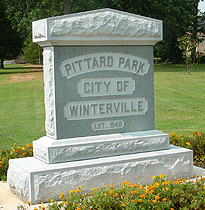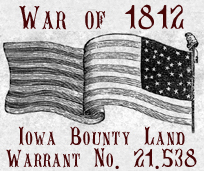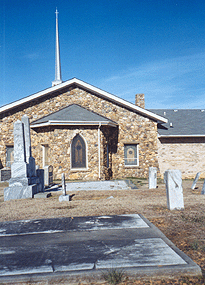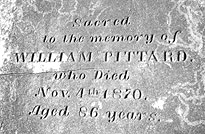Pittard:
One American Family
First Generation
Samuel / Mary Newton
Second Generation
Samuel / Ann Davis
Third Generation
William / C. Louisa Meadows
Fourth Generation
Samuel L. / Margaret J. Dillard
Fifth Generation
"Bettie" / George M. Sarrett
Resources
 |
In 1949, town organizers built a park on Pittard property to honor early Winterville, GA settlers.
|
|
 |
William's military service during the War of 1812 is documented in an 1862 U.S. General Land Office deed transfer of 80 acres of federal "bounty land" in Perry, Iowa to John S. Gable [view PDF file]. Gable sold the land to Charles Scheib 20 years later. The property and William's original patent transfer have been in the Scheib family four generations.
Contributed by Kent Scheib
|
|
 |
|
Rear view of
Woffords Crossroads
Baptist Church
Bartow County GA
In the cemetery behind the church, the large concrete slabs in the foreground of this photo mark the final resting place of William and Curacy Louisa Pittard. Directions to the church: Take White-Cassville exit off I-75 North and turn right, turn right at the first trafffic light onto White Rd., church is about three to four miles.
|
|
 |
|
Grave Marker of
William Pittard:
Sacred to
the memory of
WILLIAM PITTARD
who Died
Nov 4th 1870.
Aged 86 years.
Weathering has nearly obliterated the inscription for Curacy Louisa Meadows Pittard:
Sacred to
the Memory of
Mrs. Curacy Pittard,
Consort of William Pittard,
who was born
on the IXth day of September
A.D. 1798
and departed this life
on the 16 th day of May
A.D. 1857
... in the Lord.
|
|
|
|
Third Generation
William Pittard was born in 1784 in North Carolina, the son of Samuel Pittard and Ann Davis. Like four of his brothers, William became one of Georgia’s earliest settlers. The eldest Pittard brother, Thompson, apparently moved south first and begins appearing on Oglethorpe County land transactions as early as 1796, just three years after Georgia established it as a local government.
The City of Winterville in present-day Clarke County GA credits the Pittards as “some of the very first settlers” and “instrumental in all phases of Winterville’s development.” Descendants of William’s brother, Humphrey, donated land in 1949 for a city park bearing the family name. Winterville was part of Oglethorpe County before voting to join neighboring Clarke in 1906.
Land grants, followed by Georgia’s unique series of land lotteries, attracted pioneers from Virginia and the Carolinas. The state passed legislation to hold its first land lottery in 1805. Over the next 27 years, Georgia enacted five more drawings to dole out former Indian land to white settlers. An extra push for the Pittards to depart North Carolina may have been the lack of an inheritance. It could be mere happenstance that Thompson, the eldest and then 21, appears in Georgia about a year after his brother, John, was born both mentally handicapped and blind. However, it’s likely the older sons knew their father, Samuel, would devote his entire estate to John’s future care much earlier then 1820 when details were spelled out in his will.
Perhaps the proximity to higher learning influenced the move. According to family lore, elder Pittards had an interest in education and may have been teachers. In 1785, Georgia established Franklin College in Athens a few miles west of Winterville, making it the first state-supported university in the nation. Classes began in 1801 at what eventually became the University of Georgia.
The date of William’s arrival in Georgia is not known, but records prove he settled in Oglethorpe County, married twice, and fathered 10 children before moving to Cass (later Bartow) County. The earliest evidence of William in Georgia is his service as a private in the state militia during the War of 1812. The Georgia State Archives lists William of Oglethorpe County in Thomas’ 2nd Artillery Regiment. The federal government recognized at least a portion of his service as a volunteer soldier, and years later granted William “bounty land” in Iowa for duty in "Capt. Rope's Company Georgia Militia."
Oglethorpe County prospered after the War of 1812 as plantations became well established. William was apparently among those to thrive as numerous records have survived of him buying and selling tracts of land or witnessing other deals. With military service behind him and marriage on the horizon, William prepared to properly welcome his future bride by purchasing 90 acres “on South Fork of Broad River” from Obed Haile on Aug 15, 1814. He paid $190. William’s brother, Thompson, witnessed the transaction as did G. W. O’Kelly, probably William's future brother-in-law. Six months later on Mar 16, 1815, William married Nancy Crowder O'Kelly, daughter of Charles and Mary, in Oglethorpe County. Six months after that on Aug 14, 1815, William and Thompson witnessed the sale of 122 2/3 acres in Oglethorpe County from Mary O’Kelly, William’s mother-in-law, to G. W. O’Kelly.
On July 15, 1817, William paid James Haile $500 for 134 more acres “on South Fork of Broad River.” Just five months later on Nov 11, William sold the 134 acres plus the 90 purchased three years earlier to William Floyd for $1,200 and realized a nice profit on the $690 original investment. A few days before, William witnessed three separate sales totaling 38 Oglethorpe County acres.
Just over a year later on Jan 1, 1819, William bought 150 acres “lying on the waters of Beaverdam Creek and Bigfoot Creek” in neighboring Clarke County from his brother, Thompson, for $500. The tract adjoined lands belonging to John Morgan, William L. Parr, and Thompson Pittard.
In 1826, William and Nancy’s six children were left motherless when Nancy died. Their oldest was only 10 years old.
Georgia divided all remaining Creek Indian lands acquired in the 1825 Treaty of Indian Springs into five sections and set the stage for the 1827 Land Lottery. William drew a 202 1/2 acre lot in newly designated Lee County entitling him to land lot 216 in section 1, district 32 in the southwestern part of the state. William’s brother, Humphrey, also drew a lot in Lee County. Georgia charged lottery winners an $18 grant fee per land lot.
The state awarded multiple draws according to a wide range of domestic situations, however, William apparently won on a single chance since none of the lottery qualifications specified extra credit for a widower with a houseful of minor children. Lottery records note William’s military service, though no evidence has surfaced that he was eligible for two draws as allowed “wounded or disabled veterans of War of 1812, or Indian Wars, unable to work.”
Besides Lee County, the fifth of Georgia’s six land lotteries distributed property in Carroll, Coweta, Muscogee, and Troup Counties. The state also held lotteries in 1805, 1807, 1820, and 1821, and would hold its final drawing in 1832. It's likely William registered for earlier drawings, however, since winners were ineligible to participate in later chances, we know his only success as a “fortune drawer” was in 1827. Most fortune drawers, including William, never occupied lands acquired through the lotteries, but in a large number of cases people they sold their winnings to did.
On Mar 28, 1828, William married the woman who would become our grandmother, Curacy Louisa Meadows. Louisa, as she was known, was born Sep 15, 1798 in Newbern District, Carteret County NC, the daughter of Jacob C. Meadows and Hannah West.
In the 1830 Oglethorpe County census, 46-year-old William is listed in the “heads of families” column with four other male and six female “free white persons” noted. In the “slaves” column, the census also counted one male and one female, ages “36 to 54,” among the family of 13 attributed to William.
An economic boom spawned by Federal banking policies fueled prosperity in Oglethorpe County as elsewhere during the 1830s. Georgia planters enjoyed high market prices for their cotton crops and banks were eager to make loans. However, when the government began requiring payment in gold or silver for the purchase of public lands, the easy money and the banks that once loaned it dried up, the boom fizzled, and a severe depression seized the country in 1837. Economic decline continued into the 1840s causing cotton prices to plummet. Massive railroad construction in other parts of the state could rush cotton to market cheaply, and indirectly helped to revive Oglethorpe’s economy in the last part of the decade, but the county was passed up when officials decided where to lay the tracks.
In 1850, William, then 66 years old, wife Louisa, age 52, and four children are counted among “nearly 4,500 free citizens” in Oglethorpe County census records. Children in the household are Thomas age 20, Elizabeth age 18, and Samuel and his twin sister, listed as Amanda, age 16, all born in Oglethorpe County GA. Samuel’s twin was probably named Eliza Marida rather than Amanda. Though some sources list Eliza as a separate person and the fifth and youngest child of William and Louisa, she doesn’t appear in the 1850 census when her age is placed at about 14. After the 1850 census, Amanda vanishes from the records. She could have died early. That would explain why Eliza is mentioned in William’s will while Amanda isn’t, but that fails to account for Eliza being left out of the family’s household count in 1850. The evidence points to Amanda and Eliza being one in the same; either Amanda was Eliza’s nickname or perhaps the 1850 census taker made a mistake.
The plantation system peaked in Oglethorpe County during the 1850's. The slave population was recorded as 7,111, while whites numbered 4,382. Slave owners totaled 587, of which 120 were large planters with 20 or more slaves. But an economic decline was forcing owners of smaller tracts of Oglethrope County to sell out to larger plantation owners, William among them. Settlers began moving west for new land to plow, for soil not yet drained of nutrients from year after year of growing nothing but cotton. By the middle of the decade, William had resettled his family in Cass (later Bartow) County on a farm "near White" about four miles east of Cassville.
Our grandmother, Curacy Louisa Meadows Pittard, died May 16, 1857 at age 58 and was buried in Woffords Crossroads Baptist Church cemetery in Cass (later Bartow) County GA.
According to 1860 Cass County census records, 76-year-old William Pittard is a farmer with 24 slaves, real estate valued at $10,000, and a personal estate worth $16,500. The combined value in today’s dollars is equivalent to several million. Daughter Martha Lumpkin and her six-year old daughter, Lin, are living with the now twice widowed William. Only one third of the slaves are adults, 15 are males, and they all occupy Williams’ three “slave houses.” Son Thomas lives on one side while son Samuel is very nearby on the other. Both are listed as farmers.
Federal legislation in 1855 established land grants for volunteer soldiers of the War of 1812. Based on war-time service, William was granted “bounty land” Warrant No. 21.538, which he redeemed for 80 acres in Perry, Iowa. When William actually received the deed to the Iowa property is unknown, but he sold the land to John S. Gable in 1862 and the transfer was duly recorded by the General Land Office of the United States.
One of Kent Scheib’s earliest memories is of an old document signed by Abraham Lincoln that hung on the wall of his father’s office. The document and the Perry, Iowa land it describes have both been in the Scheib family since Kent’s great grandfather, Charles, bought the property from John S. Gable in 1882. Kent found our family website when newly installed high-speed internet prompted him to search for William Pittard, a name on the old document and once-owner of Iowa land that Kent's family has lived on and worked for four generations.
As of late 2004 when Kent originally contacted us, he and a brother still farmed the land our grandfather was given for military service to his country. Thanks to Kent's curiosity and generousity, we have a copy of the old deed.
Former soldiers were not granted federal lands outright. William had to apply for a bounty land warrant, which once granted, entitled him to use it as currency to apply for a land patent. Over the years, congress tinkered with the law, but by Mar 3, 1855 an act granting bounty land to “certain officers and soldiers who have been engaged in the military service of the United States” deposited 80 acres in favor of William Pittard under Warrant No. 21.538.
The president's name appears twice on the 1862 deed in two different handwritings, though neither signature appears to match known samples of Abraham Lincoln’s handwriting. The signature of W. O. Stoddard, one of only three secretaries in Lincoln’s White House and appointed solely to sign land patents, made the deed transfer official. In one place, Lincoln's name appears in handwriting very similar to that known to be Stoddards suggesting that he penned it for his boss.
William had the choice of several northern states and selected Iowa in which to redeem his warrant. The civil war had no affect on William’s ownership rights but he may have feared that it would, with at least two sons and two grandsons serving in the Southern army. He may have had no desire to own yankee land. More than likely, William saw no practical value in property located more than 700 miles away from his north Georgia home. Whatever the reason, the transfer to Gable, one of the few processed by the U.S. General Land Office during the war, was final on Dec 22, 1862.
During the war between the states, William's sons, Thomas and Samuel, and two Mississippi grandsons, James R. and William (sons of James H. Pittard), served in the Confederate Army of Tennessee. The four served together in Smith-Turner’s Battery, Mississippi Light Artillery during “the retreat from Chattanooga”, known today as the Atlanta Campaign, which swept through and occupied the Georgia men's own homes. All four survived the war.
William's will, prepared Sep 4, 1867 and recorded in Bartow (formerly Cass) County Will Book A & B 1836-1922 on Nov 11, 1876, mentions the following children: Francis Salina, James Humphrey, Mary Ann Smith, Nancy Lumpkin, William D. Pittard, Martha Eleanor Bishop, Thomas N., Elizabeth Lumpkin, Samuel L., and Eliza Marida Rogers. Son Thomas is named as executor and it was witnessed by Robert C. Saxon, S.B. Jones, and R.L. Saxon.
William and Louisa are buried together in Woffords Crossroads Baptist Church Cemetery, Bartow County GA. Though the inscription on William's grave is quite legible, Louisa's has all but weathered away.
Children of William Pittard and Nancy Crowder O'Kelley:
1. Francis Salina b. Jan 5 1816 in Oglethorpe County GA, m. 1st Jesse Simmons Jan 1835 in Oglethorpe County GA., m. 2nd William S. Pittard Jun 14, 1846 in Oglethorpe County GA, d. ?.
2. Nancy b. about 1817 in Oglethorpe County GA, m. A. J. Lumpkin May 3, 1848 in Oglethorpe County GA, d. ?.
3. James Humphrey b. 1818 probably Oglethorpe County GA, m. Aletha “Letha” Wood Jan 22, 1838 Oglethorpe County GA; living in Clarke County MS by 1860, d. ? Sons James R. and William served in Smith-Turner’s Battery, Mississippi Light Artillery with our grandfather, Samuel L. Pittard, and his brother, Thomas during civil war; Corporal James R. Pittard was slightly wounded during Battle of Murfreesboro (Stones River) TN; was captured along with Thomas Pittard Dec 16, 1864 at the Battle of Nashville and imprisoned at Camp Chase, OH.
4. Martha Ellen (also known as Eleanor) b. about 1820 in Oglethorpe County GA, m. William W. Lumpkin Jan 27, 1849 in Oglethorpe County GA, d. ? According to 1860 census, Martha Lumpkin was born in 1832, which would have made her the child of William and Louisa.
5. William Davis b. Mar 1 or Mar 31, 1824 Oglethorpe County GA, m. Emily Ann Glenn Nov 20, 1858 Oglethorpe County GA, d. Nov 11, 1895 Oglethrope County GA, buried Winterville, Clarke County GA.
6. Mary Ann b. about 1826 m. William Harrison Smith, d. ? Mary Ann and William Harrison Smith are listed in the Oglethorpe County GA census in 1850 and 1860, and in Clarke County, MS by 1880. Both are listed as having been born in GA, Mary Ann perhaps as early as 1820 and W. H. Smith about 1815.
Children of William Pittard and Curacy Louisa Meadows:
1. Thomas N. b. Nov 28, 1829 in Oglethorpe County GA, m. Harriett A. “Anne" or “Annie” Holcomb, 1854 at Lexington, GA, Oglethorpe County.
Dec 3, 1861 - signed for his father, William, a receipt for 25 cents for "hauling a hogshead of beef" for the Confederate States from Cass Station in Bartow Country GA "to Camp", presumedly Camp McDonald at Big Shanty (now Kennesaw). A copy of the receipt was made for his father, "Hon William Pittard".
Mar 4, 1862 - enlisted as private Co. I, 40th Regiment, Georgia Volunteer Infantry Brigade
Aug 1862 - listed as 40th GA “substitute musician”
July 4, 1863 - among 25,000 Confederate troops surrendered after Vicksburg seige, paroled and exchanged
Feb 22, 1864 - enlisted for the duration of the war in Capt. Wm B. Turner’s Mississippi Light Artillery, Smith-Turner's Battery, CSA
Mar & Apr 1864 - “present for duty,” served extra duty on Infirmary Corps
May & Jun 1864 - “absent, sent to hospital wounded”
Dec 16, 1864 - captured during Battle of Nashville when pressure from being attacked on three sides forced Cheatham's line positioned on the left at steep Compton's Hill (today's Shy Hill) to break.
Jan 2, 1865 - received as prisoner of war, Military Prison, Louisville, KY
Jan 4, 1865 - transferred to Camp Chase, OH as prisoner of war
Jan 6, 1865 - received at Camp Chase, OH, prison
Feb 25, 1865 - paroled at Camp Chase, OH, transferred to City Point, VA for exchange
Mar 16, 1865 - released as prisoner of war upon taking the oath of allegiance to the U.S. government and promising to remain in the loyal states during the war
Died. Sep 11, 1907, buried Cassville Cemetery, Bartow County GA.
2. Elizabeth b. about 1831, m. William Henry Lumpkin Dec 18, 1850, d. ?
3. Samuel Lafayette, a twin, b. Dec 11, 1833 Oglethorpe County GA, m. Margaret Jane Dillard Nov 10, 1858 Cass (later Bartow) County GA
Mar 4, 1862 - enlisted as private Co. I, 40th Regiment, Georgia Volunteer Infantry Brigade
July 4, 1863 - among 25,000 Confederate troops surrendered after the Vicksburg seige, paroled and exchanged
Aug 1863 - began six-month enlistment as a private, Co. D, 10th Battalion Georgia Cavalry, State Guards
Feb 11, 1864 - enlisted at Kingston, Bartow County, GA for duration of the war in Capt. William B. Turner’s Mississippi Light Artillery, Smith-Turner's Battery, CSA
Mar 25, 1864 - began 40-day furlough
May/Jun 1864 - “present for duty”
Late 1864 - “taken sick” at Columbus, MS, sent home on sick furlough, “never able for service any more, which condition was shown by a physician’s certificate.” According to family lore, he walked home from Mississippi
Died. May 23, 1900, buried Cassville Cemetery, Bartow County GA.
* 4. Amanda , a twin, b. Dec 11, 1833, m. ? d ?.
* 5. Eliza Marida b. Aug 20, 1835, m. Robert L. Rogers Dec 23, 1853 in Cass (later Bartow) County GA, d. Jun 22, 1892. Lived in area of Cass (later Bartow) County GA that became known as Rogers Station.
* Evidence suggests that Amanda and Eliza may actually be the same person.
|